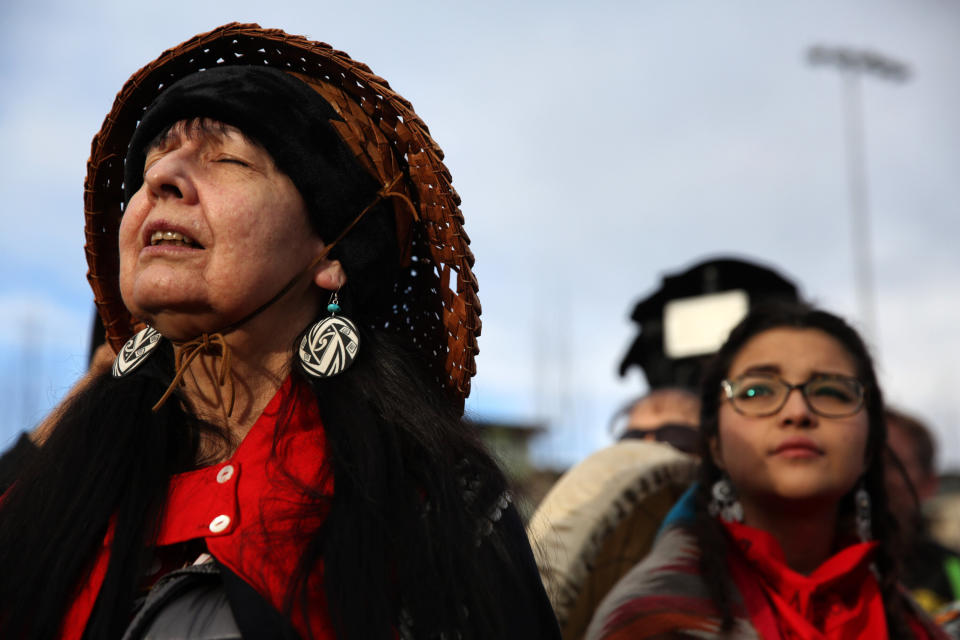Deb Haaland 'Absolutely' Focused On Tackling Violence Against Native Women
- Oops!Something went wrong.Please try again later.
In late 2018, before she was interior secretary and before she was a member of Congress, Deb Haaland sat in the back during a Senate committee hearing on missing and murdered Indigenous women.
One of the witnesses at the hearing, a Native American woman, talked about her sister disappearing. The woman described seeing her sister’s sweater on the side of the road, and reporting it to police as a clue to help figure out what had happened. When the woman went by that spot again two weeks later, the sweater was still there.
That story stayed with Haaland. It was a stark reminder that law enforcement and government officials just haven’t been dedicating enough resources or time to stopping what has been a horrifying, decadeslong crisis of Native women disappearing or being killed.
Now that she’s the interior secretary ― the nation’s first-ever Indigenous Cabinet secretary at any agency ― Haaland is in a position to tackle the situation head-on.
Doing so is “absolutely” a top priority of the Interior Department, Haaland told HuffPost in a Zoom interview on Tuesday, which you can watch above.
“We need to build the opportunities for law enforcement and for people to feel like people care about this issue. Women are going missing because women are easy targets,” she said. “It’s particularly stark in Indian Country.”

It’s a complicated problem involving systemic violence and human trafficking, and there is next to no data available on what, exactly, is happening. At least 506 Indigenous women and girls have gone missing or been murdered in 71 U.S. cities, including more than 330 since 2010, according to a November 2018 report by Urban Indian Health Institute. But that’s likely a gross undercount, given the limited — or total lack of — data being collected by law enforcement on these crimes. Ninety-five percent of these cases were never covered by the national media, per the report, and the circumstances surrounding many of these deaths and disappearances are still unknown.
This is happening in the context of Native women already facing staggering levels of violence. A whopping 84% of Indigenous women experience violence in their lifetime, and in some tribal communities, Native women are murdered at 10 times the national average.
Haaland, a member of the Laguna Pueblo tribe who is just over a month into her new job, has been plowing ahead on the issue. She significantly beefed up staff and resources at a Bureau of Indian Affairs’ unit charged with investigating cases of missing and murdered Indigenous women. She also announced a joint commission with Attorney General Merrick Garland to bring together law enforcement, tribal leaders, federal partners and survivors to hold hearings, take testimony and come up with recommendations for the government to combat violence against Native women.
She has a strong ally in President Joe Biden, who authored the Violence Against Women Act and has made it one of his legacy issues. The White House held its first Council on Native American Affairs meeting last month, which Haaland said would be another venue for pushing for more attention on violence against Indigenous women.
Women are going missing because women are easy targets. It’s particularly stark in Indian Country. Interior Secretary Deb Haaland
But back to that sweater. Why was it still sitting on the side of a road, two weeks after it was reported to police as evidence of a possible crime?
Haaland said part of the problem with addressing the pattern of missing and murdered Indigenous women has been a lack of resources. Another problem has been jurisdictional, with different law enforcement agencies ― tribal, federal, local ― having different says on certain crimes. And then part of the problem is simply people not treating the situation with urgency.
“Yes,” she said when asked if the government and law enforcement have fallen short. “Which is why we want to put our arms around this whole issue and make it an all-of-agency approach, and make sure that we are doing everything we can to provide the leadership and move this issue forward as it should be.”
Haaland has at least three and a half years to try to make a dent in the epidemic. She offered two pretty basic metrics for measuring success: the rates of missing and murdered Native women will drop, and the backlog of unsolved cases will shrink. One Indigenous-led research group, the Sovereign Bodies Institute, documented 2,306 missing Native women and girls in the U.S. The vast majority of those cases remain unsolved.
“There is a large number of family members right now who have no clue where their loved ones have gone. They’re missing,” Haaland said. “Part of the goal of the Missing and Murdered Unit is to ensure that we can go after those unsolved cases and solve them, so that family members don’t have to wonder anymore. They need some closure. ... Yes, they need some closure.”
Related...
Biden Administration Makes It Easier For Tribes To Reacquire Lands
Biden’s Pick For No. 2 At Interior Has Numerous Ties To Fossil Fuels
Deb Haaland: 'Unfortunate' That Rick Santorum Doesn't Know Native American History
This article originally appeared on HuffPost and has been updated.

